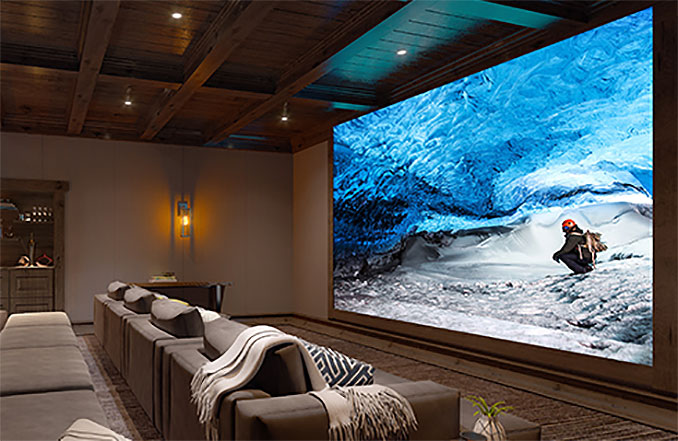Sony’s Micro LED-Based Ultra-HD TVs Available to Consumers: 2K to 16K Resolutions, up to 790-Inches
by Anton Shilov on September 19, 2019 11:00 AM EST
Sony this month started to offer its Micro LED-based displays to well-funded consumers. Officially branded as Crystal LED direct view display systems (aka CLEDIS), these ultra high-end products were previously only available for commercial installations. Designed to offer superior contrasts, brightness levels, and viewing angles, Sony’s Crystal LED TVs are designed to replace projector-enabled home theaters and will be available in 2K, 4K, 8K, and 16K versions with sizes of up to 790 inches.
Sony’s Crystal LED display systems rely on bezel-less Micro LED modules that are built using 0.003-mm² individually-controlled LEDs. The modules offer up to 1000 nits peak brightness, around 1,000,000:1 contrast ratio, up to a 120 Hz refresh rate, as well as nearly 180° viewing angles. According to Sony, such a display can cover 140% of the sRGB color space or around 100% of the DCI-P3 color gamut.
Since the micro LED modules are rather large – even though they're the fraction of the size of a normal LED, the large number of micro LEDs adds up – the size of a Full-HD Crystal LED display system is around 110 inches in diagonal. Meanwhile the 4K unit doubles that, to 220 inches. Since we are dealing with devices that are designed to replace projection-powered home theaters, such sizes are well justified, but they are naturally too large for an average home.
| Sony's Consumer Crystal LED Display Systems | ||||||
| Full HD | 4K | 8K | 16K | |||
| Number of CLED Modules | 18 | 72 | 288 | 576 | ||
| Diagonal | 110-inches | 220-inches | 440-inches | 790-inches | ||
| Dimensions (W×H) | 8 ft × 4 ft 2.43 m × 1.22 m |
16 ft × 9 ft 4.87 × 2.74 |
32 ft × 18 ft 9.75 × 5.48 |
63 ft × 18 ft 19.2 × 5.48 |
||
| Approximate Price of CLEDs at $10,000 per unit | $180,000 | $720,000 | $2,880,000 | $5,760,000 | ||
Sony’s Crystal LED-based display systems for residential installation will be available through a select group of individually trained and certified Sony dealers. The devices will be supported by Sony’s technicians, who will be able to remotely monitor displays after their installations to provide ongoing service.
Sony is not publicly quoting prices for its consumer Crystal LED products, but there are estimates that each module costs around $10,000 per unit. This would mean that a Full-HD version, which consists of 18 modules, costs over $180,000, whereas a 4K system will be priced at over $720,000.
Related Reading:










46 Comments
View All Comments
stepz - Friday, September 20, 2019 - link
10'000 nits is fresh snow in direct sunlight level of brightness. I personally don't find advertisements with that kind of brightness to be "highly desirable".Santoval - Monday, September 23, 2019 - link
How about 1+ million nits? Yeap, much denser microLEDs (5000 PPI) from this company can do that : https://youtu.be/N8QZVkRe9vQOf course, as they say, these prototype mini screens are just a demonstration of what microLEDs can do, they don't actually plan to sell panels 1 million nits bright (except perhaps for AR use?).
By the way, for a panel under direct sunlight a brightness of 8 - 12,000 nits *is* highly desirable. Only at that time though. When she sun does not shine on it it should automatically get dimmer. That can easily be done via sensors.
s.yu - Sunday, September 22, 2019 - link
...Indeed.reckless76 - Thursday, September 19, 2019 - link
Well.. Guess put me down for two of them. I'll take the 4k for my theater room, and the Full HD for my other theater room. I'd go for the 8k, but my wall just isn't quite big enough. And no. I don't think it's silly to buy TVs for three times the worth of my house. (Also, I don't have any theater rooms, but I'd thank you to please keep your reality away from my fantasy.)chrnochime - Thursday, September 19, 2019 - link
An HD and a 4K Sony LED TV can't get a house here in SV so yeah these are actually cheaper than a house for us LOLeek2121 - Thursday, September 19, 2019 - link
I might be able to finance the cheaper one over 15 years, but yeah...with how quickly technology pricing drops? No thanks.Duncan Macdonald - Thursday, September 19, 2019 - link
Probably multiple reasons for the space round each micro-LED1) having a gap allows factory rework if a LED is faulty rather than junking an entire module
2) heat dissipation - if the micro-LEDs were closer together it might be difficult to keep them cool without a noisy cooling system
3) the people likely to buy these systems for home use are the sort who want their toys to be large and impressive
Santoval - Thursday, September 19, 2019 - link
Most likely it's #2. If you go to Sony's page about this tech (via the link early in the article) you'll see that these modules appear to be very thick and probably quite heavy. The cooling solution has two large fans which I'm sure are blowing hot air away from a heavy copper cooler inside. If they increased the microLED density by 4 or 8 times the heat and power draw would blow up and they would probably need to attach a freezer on the back of each module.twtech - Thursday, September 19, 2019 - link
Now if they could figure out a way to sell them for, say, 1000x less - even 250x less - they could probably sell a lot of them.SanX - Thursday, September 19, 2019 - link
Why hurry? In 10 years all these 3 zeroes at the end will disappear by themselves.